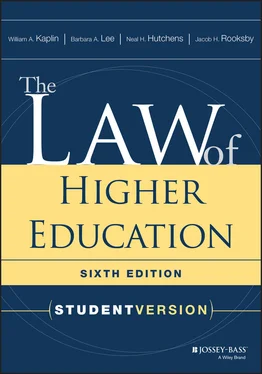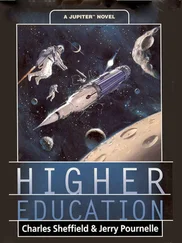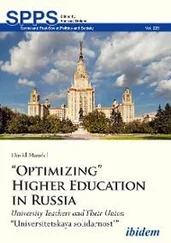It was important to the court's reasoning that the “Holier Than Thou” statue was displayed on a university campus rather than, say, in a city park or on the grounds of a county office building. The court emphasized that a campus is “peculiarly the marketplace of ideas” (citing Healy v. James , 408 U.S. at 180), a place where government “acts against a background and tradition” of academic freedom(citing Rosenberger v. Rector & Visitors of Univ. of Va ., 515 U.S. at 835)). Moreover, the placement and retention of the statue, in context, had implicated the university's educational mission and its curriculum. Even though the statue was not created as part of a course, it was nevertheless “part of [the university's] educational curriculum”; the president and the vice president of academic affairs had both “testified that they strove to extend the educational environment…beyond the classroom to encompass various stimuli including art, theatre, music, debate, athletics, and other activities.”
Apparently, in such academic, higher education contexts, courts may accord public colleges and universities more leeway than other governmental entities to establish religiously neutral educational reasons for engaging in activities that involve religion in some way. Similarly, in this context, courts may find it less likely that a reasonable observer “would associate” a particular, allegedly religious message with the college or university itself (416 F.3d at 1229–30). More broadly, these attributes of higher education serve to support the assertion, made by the U.S. Supreme Court and repeated by lower courts, “that religious themes ‘may constitutionally be used in an appropriate study of history, civilization, ethics, comparative religion, or the like’” (416 F.3d at 1230, quoting Stone v. Graham , 449 U.S. 39, 42 (1980)).
The U.S. Supreme Court case, Pleasant Grove City v. Summum , 555 U.S. 460 (2009), introduces an additional dimension to cases like O'Connor v. Washburn University . In particular, Pleasant Grove illustrates how there could be not only an establishment challenge but also a free speech clause challenge to a governmental entity's placement or rejection of placement of religious monuments or statues on public property. Faced with such a challenge, according to the Court, the governmental entity may often prevail by characterizing the placement of the monument or statue as “governmental speech” rather than “private speech.” Success with this argument, however, would not insulate the governmental entity from an establishment clause challenge, which requires a separate analysis as illustrated by O'Connor .
Section 1.7. The Relationship Between Law and Policy
There is an overarching distinction between law and policy, and thus between legal issues and policy issues, that informs the work of administrators and policy makers in higher education, as well as the work of lawyers. 12 In brief, legal issues are stated and analyzed using the norms and principles of the legal system, resulting in conclusions and advice on what the law requires or permits in a given circumstance. Policy issues, in comparison, are stated and analyzed using norms and principles of administration and management, the social sciences (including the psychology of teaching and learning), the physical sciences (especially the health sciences), ethics, and other relevant disciplines; the resulting conclusions and advice focus on the best policy options available in a particular circumstance. Or, to put it another way, law focuses primarily on the legality of a particular course of action, while policy focuses primarily on the efficacy of a particular course of action. Legality is determined using the various sources of law set out in Section 1.4of this book; efficacy is determined by using sources drawn from the various disciplines just mentioned. The work of ascertaining legality is primarily for the attorneys, while the work of ascertaining efficacy is primarily for the policy makers and administrators.
Just as legal issues may arise from sources both internal and external to the institution (see Section 1.4), policy issues may arise, and policy may be made, both within and outside the institution. Internally, the educators and administrators, including the trustees or regents, make policy decisions that create what we may think of as “institutional policy” or “internal policy.” Externally, legislatures, executive branch officials, and administrative agencies make policy decisions that create what we may think of as “public policy” or “external policy.” In either case, policy must be made and policy issues must be resolved within the constraints of the law.
It is critically important for institutional administrators and counsel to focus on this vital interrelationship between law and policy whenever they are addressing particular problems, reviewing existing institutional policies, or creating new policies. In these settings, with most problems and policies, the two foundational questions to ask are, “What are the institutional policy or public policy issues presented?” and “What are the legal issues presented?” The two sets of issues often overlap and intertwine. Administrators and counsel may study both sets of issues; neither area is reserved exclusively for the cognitive processes of one profession to the exclusion of the other. Yet lawyers may appropriately think about and react to legal issues differently than administrators do; and administrators may appropriately think about and react to policy issues differently than do attorneys. These matters of role and expertise are central to the process of problem solving as well as the process of policy making, in particular for internal policy. While policy aspects of a task are more the bailiwick of the administrator and the legal aspects more the bailiwick of the lawyer, the professional expertise of each comes together in the policy-making process. In this sense, policy making is a joint project, a team effort. The policy choices suggested by the administrators may implicate legal issues, and different policy choices may implicate different legal issues; legal requirements, in turn, will affect the viability of various policy choices. 13
The administrators' and attorneys' roles in policy making can be described and differentiated in the following way. Administrators identify actual and potential problems that are interfering or may interfere with the furtherance of institutional goals or the accomplishment of the institutional mission, or that are creating or may create threats to the health or safety of the campus community; they identify the causes of these problems; they identify other contributing factors pertinent to understanding each problem and its scope; they assess the likelihood and gravity of the risks that these problems create for the institution; they generate options for resolving the identified problems; and they accommodate, balance, and prioritize the interests of the various constituencies that would be affected by the various options proposed. In addition, administrators identify opportunities and challenges that may entail new policy-making initiatives; assess compliance with current institutional policies and identify needs for change; and assess the efficacy of existing policies (How well do they work?) and of proposed policies (How well will they work?). Attorneys, in contrast:
Identify existing and potential problems that create, or may create, exposure to legal risk for the institution or that may raise legal compliance issues
Analyze the legal aspects of these problems using the applicable sources of law ( Section 1.4)
Generate legally sound options for resolving these problems and present them to the responsible administrators
Читать дальше












